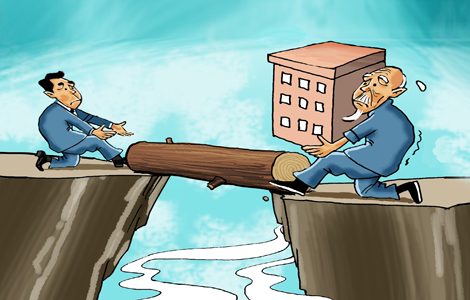Lessons from subsidizing the solar industry
Updated: 2013-06-27 21:45
(chinadaily.com.cn)
|
|||||||||||
Due to the excessive capacity in the solar industry, coupled by the worsening external trade environment, it is imperative to launch and stimulate the domestic market. Imposing a feed-In tariff is one of the major subsidies for the solar industry. But it should be carefully considered whether substantial subsidies are able to save China's solar industry, says an article from the Oriental Morning News. Excerpts:
In general, governments' subsidies have two major aims: One is to encourage innovation and the other is to support disadvantaged groups.
As for the solar industry, subsidies are applicable in terms of both aims. As an emerging industry with a distributed power supply system, the solar industry has the potential to transform energy unitization and will promote sustained growth; at the same time, in an industrial era geared by increasing capital, manufacturing productivity and international trade, solar capacity surged within just a couple of years.
The kernel is: can subsidies really save China's solar industry? In fact, past policies have led the industry into a development circle dependent on subsidies. In the past, various forms of subsidies have been applied to promote and stimulate solar industry development, then the building of PV power stations.
While the current situation shows that subsidies only yielded outputs, and consumed prior capacity have not fueled domestic demand. In the end, the development of the whole industry is reduced to being heavily reliant on subsidies.
Some lessons should be learned for the industry's future development. Subsidy policies should not forget that the solar industry is an emerging sector. Subsidies should target the areas critical to the industry's growth, such as technology innovation, and should not go beyond broader or all-inclusive areas. Also, industry protection should not be the main purpose. If need be to support disadvantaged sectors, a more direct and effective way may to pay the bills for those solar companies that go through bankruptcy, mergers and layoffs. It is suggested to leave the supply and demand of solar products to the market.
Related Stories
Talks taking place with EU over solar panel exports 2013-06-25 07:41
Solar products heat up dispute 2013-06-25 06:59
China, EU 'goodwill' voiced in solar row 2013-06-22 01:33
The solar-panel ball is in the EU's court 2013-06-18 08:08
Today's Top News
4 caught over killings of Chinese in PNG
Rudd sworn in as Australian prime minister
China slams Japan's new defense white paper
IBM to make Chinese job cuts
Building equipment sector shifts overseas
Stocks hold steady, but brokers still cautious
China can curb credit crunch: ADB official
Mandela still critical, Zuma cancels trip
Hot Topics
Lunar probe , China growth forecasts, Emission rules get tougher, China seen through 'colored lens', International board,
Editor's Picks

|

|

|

|

|

|





